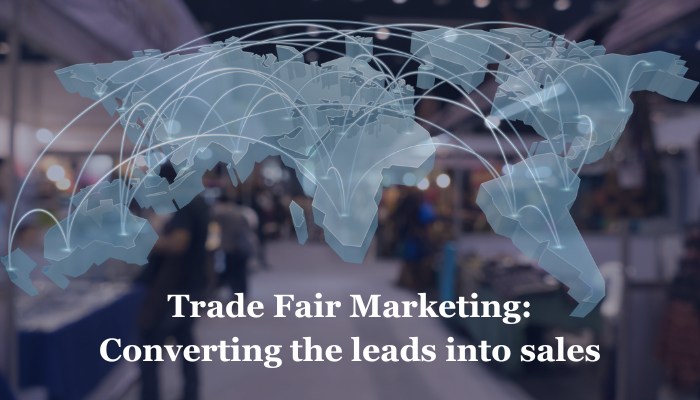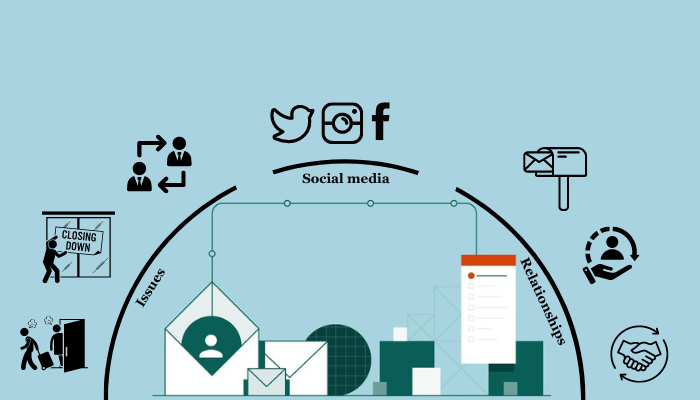Table of Contents
Trade fair marketing: Converting the leads into sales

A charm offensive to lure the buyers, people in the smart business wear networking and interacting with prospective buyers and businesses, hidden in a corner or on a spotlight platform with an opportunity to speak as a panelist – attending a trade fair or expo show is exhilarating for small businesses and big players alike. Even if small companies are at the bottom of the exhibitors list, a trade fair is a level playing field that brings two sides of a table together and allows them to close the sales face-to-face. But is it that simple? Or black and white?
While lead generation is the primary and top-most reason to attend trade shows, many businesses find that trade show exhibitors data is a lost cause. Only 6 percent of exhibitors think they have the skills or confidence to convert a lead into sales. Besides, it is never really the same. Even though a trade show lead conversion is 38 percent cheaper than making a sales call, businesses struggle to simplify the journey of this sales funnel.
Let’s find out what successful exhibitors are doing and what unsuccessful exhibitors are failing at.
Integrated Media Marketing Campaign:
A study reveals that 28 percent of trade show exhibitors plan their marketing strategy ahead and around the tradeshow, and almost 42 percent of businesses deep dive and use email marketing as an effective tool to create awareness around their presence. A whopping 76 percent of companies, however, understand the importance of using social media and digital presence to create a positive buzz and increase presence at their booth.

A key aspect of creating a successful marketing campaign is to identify two segments:
Your Competition:
Businesses must dive deep into the conference exhibitors list to determine their competition. It can help them understand their strategy and floor and venue pricing expectations. It may be last year’s data, but a vis-à-vis comparison can give visibility and help build a better marketing strategy framework. This exercise can also help businesses understand the pain points and issues faced earlier by skimming through exhibitors data and tailoring their content and design accordingly.
Your Audience:
Are you a B2B small business or a commercial industrial company? Or are you a niche D2C brand? As 64 percent of event attendees are new, understanding your targeted audience is crucial. Are you here to network or looking for new partners to expand? Or are you looking to promote a recently launched product or service and listen to feedback to improve it? Most importantly, why are the attendees coming to the exhibition? Are they closing the deals or testing the waters? This can be resolved by curating the exhibitors database and case studies specifically designed for your business. This is literally the top part of the lead generation funnel, where a company identifies the potential audience or customers and misses out on it.
Once a company has these two things figured out, it can craft an integrated marketing strategy to create positive word around its presence in the trade show. A trade fair marketing plan should have three phases:
Pre-marketing buzz:
Contrary to businesses and companies believing that on-site marketing is the real test, this is where it all begins. Once a business has identified its prospects and peers, it is time to utilize relevant channels to cut through the clutter and reach out to the ones who matter. Before the event, an email marketing campaign, long-form content strategy, and social media content marketing should be in place, including an influencer marketing plan, pop-ups on the website, and newsletter announcements. The communication should be in sync and phases to not bombard the prospective audience and buyers with spam.
On-site event marketing:
The epicenter of all the preps, planning, and training businesses prepare for. The day they have been waiting for. How well is the sales team prepared for it? Is it well-trained to respond to questions? Is the communication in sync with the campaign? Is the sound and visual system all set for the interactive show at the booth? Has the team found a way to reach out to the exhibition attendees and keep the trade show email list ready with them for the follow-up? Or is it still the ancient ‘visiting cards in the glass vase’? Does the team have details ready from the conference list to determine the frequency of footfalls and eyeballs? Has the team planned a diversified engagement strategy to woo prospective buyers and stand out? The on-site event team must be mentally and strategically prepared to align their communication regarding the product or services offered and stay open to instant feedback. If used correctly, trade shows can be an excellent platform to equip better and train the sales staff to know the products/services inside-out. Live recording at the booth is not a bad idea, considering it might give the staff ways to figure out who walked to the booth and how they can improve. It can also help them put faces to the names and revisit the conversation they would follow up with.
One crucial thing to ponder is that companies should use trade shows and exhibitions to network with prospective buyers, trade show attendees, and fellow exhibitors. Their teams should utilize exhibitors data and prepare beforehand to know industry trends and identify potential network and business opportunities. They should not be limited to the dais or booth only but should also attend webinars, sessions, and live panels to upskill themselves and hobnob with their colleagues in the industry.
Post-event follow-ups:
The work doesn’t end here. It has just started. Over 84 percent of trade show attendees, or four out of five people coming to a booth, have decision authority, which means that this is a business’ chance to push them further down the lead generation sales funnel and close a deal. These attendees can spread the positive word about a business or service that no marketing spending can outperform. So, this is when businesses need to dish out an exhibitors list and use it to send surveys, continuing education material, subscription offers, promotional materials, invitations for a webinar, or interview requests. People appreciate being remembered, and businesses are trying to do that.
It is important to set up a consistent post-event cadence that is non-annoying and not-in-the-face sales-y as the sales team might have to follow up at least five times, and it may take anywhere from three to twelve months. Until then, keep updating the exhibitors email list, and working on the strategy to reapproach them is the only shot businesses have.
An outdated trade show email list:

While inviting the trade show attendees for a webinar, requesting them to follow on social media or organizing a giveaway is a brilliant tactic, nothing could beat the good old email marketing. The single opt-in email marketing program has an 80 percent higher return, which is $36 for one dollar spent, varying industry-wise, content used, testing regulations, and size of the program. No wonder it is the weapon of choice for small business marketers, but using an outdated and old trade show email list can nullify all the gains a business has made until now.
With subscriber segmentation, there may be a chance at redemption, but people move out of the country, change their jobs, close their existing businesses, and start something new all the time.
Sure, winning the inactive exhibitors database and repurposing it to identify which ones to keep for cementing the relationship is tempting and understandably so. After all, getting a new customer is five times costlier than retaining an old one, but it could hurt your deliverability if you keep sending emails to an inactive base and they keep bouncing back. Your email service provider can mark your emails as spam or promotion and may perceive your business as such. Nowadays, Google asks its users if they want to unsubscribe from a particular promotional email if they aren’t opening any email from that sender. So, maybe not directly, keeping inactive, unengaged subscribers and using an old exhibitors email list may cost a business more.
No guardrails for email content and marketing:

Sure, you have a fresh and latest expo list delivered and downloaded and raring to go at your command, but it is time to look beyond the email addresses if you still do not see any results. There are 4.26 billion email users, expected to increase by 4.73 billion by 2026. What makes your mass emailing special when 333 billion emails are being sent and received worldwide?
The key to standing out here is using customized email content drafted to appeal to your targeted audience. Using animations and interactive graphics with personalization is also a wonderful way to increase your CTR and can enhance email performance tremendously.
While long-form content in email is a big No-No, linking them to your blog or any other knowledge repository is appreciated. Using social share buttons can also help you to create a connected campaign. Besides, not testing emails for QA, A/B testing, and spam can drastically reduce the performance of exhibitors email lists. In contrast, businesses see a 28 percent higher ROI if relevant QA measures are implemented. Also, this research states that it is against email etiquette to send marketing emails on Sundays, and Tuesdays are better. Businesses should also refrain from sending a marketing email from 1 AM – 3 AM EST.
Since many of us use smartphones, sending emails that aren’t heavy, don’t take too much time to download, and are mobile-friendly makes sense.
Undermining User-generated content:
Often, small businesses feel robbed when they can’t match the marketing spending of bigger companies at a trade show. They can capitalize on user-generated content such as surveys, testimonies, and social media content at an event and go big through word of mouth! Besides, using a conference exhibitors list to email your target base is a great leveler that they can use to maximize their reach and identify prospective buyers. While it isn’t financially viable for small businesses to attend every expo and trade show, they can still extend their base using the exhibitors database.
How can Exhibitors Data help?
The impact of the pandemic is still evident in the global exhibition industry, resulting in trade losses worth $330 billion in 2020. While it is expanding at 30 percent yearly, it will only reach its pre-pandemic potential by 2026. However, regardless of size and industry, businesses continue to benefit from meeting potential buyers in person through a trade show.
Many businesses think that the journey of the trade fairs to lead conversion is simple, which is somewhat convoluted and laden with barriers. Fortunately, these barriers can be quickly addressed with the right approach. Using a conference list and database is the first step of lead generation best practices and can significantly increase a business’s chances of clocking in more sales.
You can get a targeted and segmented exhibitors email list with Exhibitors Data. Close more sales and grow your business by reaching out to industry-relevant executives!
You can also download a sample industry-specific exhibitors email list here.
You can also contact us to arrange a demo call or to request a curated expo list for your business. We are just a click away.

How a Tech Company Reached CES Decision-Makers Amid Fragmented Exhibitor Data
CES Exhibitor Data When a mid-sized technology company wanted to plan targeted outreach ahead of CES 2026, they faced a critical problem: identifying and connecting with C-Level decision-makers from exhibitors...
